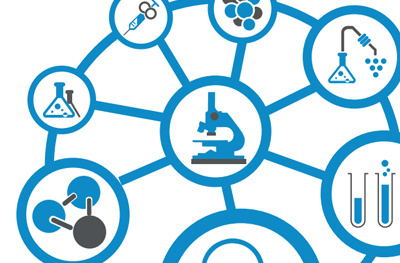by | Beata Poteralska, Institute for Sustainable Technologies – National Research Institute, ul. K. Pulaskiego 6/10, 26-600 Radom
The article presents methodology of forecasting research directions crucial for the development of the competitiveness and innovativeness of the Polish enterprises and technological institutes.
The application of the methodology is presented on the basis of environmental technologies, one of the key areas of technical support for the economy’s sustainable development.
With the use of the developed methodology, future research directions have been identified together with key incremental and emerging technologies within them, for whom technology characteristics cards have been created. Following that, R&D directions have been roadmapped and scenarios of technological and educational (qualifications and competences) development have been designed.
Innovativeness and competitiveness of advanced product and process technologies are the deciding factors in the selection of development directions and the development pace of a contemporaryknowledge-based economy. The actions taken to design and implement environmental solutions are one of the key areas of technical support for the sustainable economic development. As far as this particular area is concerned, the design of future short- and long term environmental solutions including, among others, the elimination of inefficient, energy consuming and high-waste industrial technologies as well as the limit on raw materials and resources wasteful management is really necessary.
Introduction of the EU and national regulations and documents stimulating the development of environmental technologies and the inclusion of ecological priorities in strategic research programmes confirm the importance of research activities for the development of ecological solutions. An example of the document of the key importance are the directives of the European Union directed at the creation of system requirements for the development of eco-friendly technological processes and the undertaking of activities minimising and managing the amount of waste created through pure ecological utilisation, for instance. Strategic research directions are identified in governmental documents and long term plans for the organisation of the scope of activity of the European and national technology platforms. The problem of environmental technologies ranks high on the priority list of national and international research programmes as well.
Determining priority research directions and key technologies
In order to use the existing resources effectively and improve the level of competitiveness of national economy, it is necessary to indicate strategic research directions that would comply with the European and national priorities and take the existing scientific and infrastructure potential in the undertaken thematic area into consideration.
To determine priority future research directions, the methodology of their identification in the areas of strategic importance was designed.1 The article presents procedures for conducting research and the effects of the application of the designed methodology in relation to the area of environmental technologies.
It was assumed that priority research directions would be determined with consideration of the existing scientific and technological potential and its growth forecast for the next 5-10 years, which is the time brackets for the realisation of generated research tasks and directions.
Both the micro scale – understood as the generation of research directions realised at scientific institutions, and the macro scale – understood as the consideration of research directions strategic for the country’s development and inspired by the results of sectoral foresights, and the consideration of the strategic documents and directives of the European Union were applied.
It was assumed that the determined research directions should comply with the following criteria:
a. The application potential of research results and their implementation in the process of innovative technologies development on the 5-15 year horizon;
b. The interdisciplinarity of solutions and their potential influence on economy’s sustainable development;
c. The scientific and technological level of solutions complying with the highest global standards.
The analyses of research projects realised at R&D institutions dealing with the subject matter of environmental technologies were the starting point for conducted research. They were the basis for the formulation of general, leading research directions realised by scientific institutes.
Among the key mechanisms of generating future research directions were the analysis of the state-of-the-art and the expert analyses.
The convergence of identified research directions with directions of research conducted by national and international R&D institutes played an important role. For this purpose the analyses of the state-of-the-art were conducted on the basis of the following:
a. Strategic Documents For The Creation Of Country’s Industrial Policy And Eu Documents;
b. Subject And Results Of National And International Foresight Project;
c. Selected Publications (I.E. In Journals By Elsevier And Springer);
d. Conference Materials From Selected Significant International And National Conferences;
e. Reports On The Research Activity Of Leading Technological Institutes And Catalogues Of Innovative Products In The Area Of Environmental Technologies;
f. Patent Databases.
The analysis of the state-of-the-art was done in the iterative system and formed the basis for the identification of priority research directions, within which the literature analysis of the current state-of-the-art allowing to determine the most important, and previously not incorporated research directions was conducted. The verification of the priority research directions was thus possible. The description of the state-of-the-art included both the cognitive performance of Polish, European or international scientific institutions leading in a given domain and the technological achievements resulting in innovations complying with worldwide standards and ready to be commercially deployed. The results obtained embrace general research directions on the national and global level and integrated groups of these directions in a selected area of strategic importance comprising environmental technologies.
The aim of the expert analyses was to support the analysis of the state-of-the-art. External experts representing the science, industry and public administration sectors, who had not participated in the initial identification of future research directions, assessed the priority research directions in the scale of the country and the sector. The consideration of the experts’ remarks enabled the modification and extension of the proposed research directions, and in consequence the selection of new future research directions.
Within realised tasks, future research directions for the strategic research institute – Institute for Sustainable Technologies – National Research Institute (ITeE-PIB) in Radom, Poland were determined and on that basis, leading research directions were generated for the sector conducting environmental research with the attention paid to the needs of the country and incorporating integrated leading directions of research conducted in that domain globally.
The analysis of the key development trends and the research results in the domain of industrial technologies influencing the improvement of the environment condition enabled the identification of priority research areas that would allow for the development of innovative technological solutions with high implementation potential. In a presented thematic area, the priority directions of environmental technologies include:
a. technologies of producing maintenance materials with increased maintenance values,
b. technologies for the rationalisation of the use of raw materials and resources,
c. technologies of waste recycling and utilisation,
d. low-waste technologies of manufacturing and regenerating machines and devices,
e. pro-ecological technologies of producing energy,
f. logistics systems for waste and energy management.
Detailed key research directions were identified in aforementioned priority areas.
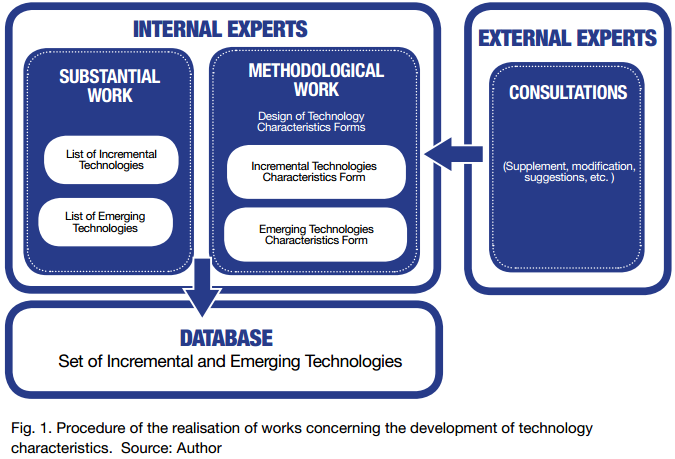
The next stage of the undertaken research concerned the generation of lists of priority technologies and the design of characteristics of identified technologies. Works focused on the development of priority technologies and the creation of forms for the design of characteristics were conducted simultaneously by the internal experts – representatives of the project coordinator and the external experts. The outline of realised activities is presented in (Fig. 1).
Generated priority technologies were then assigned to two groups: incremental and emerging technologies. The first of them influences a short and long term subject area of R&D activity in Poland and it concerns the 5-year planning period, whereas the latter enables the development of guidelines for a long term strategy of R&D institutes research activity, and it deals with the 10-15-year prognosis. Incremental technologies are technologies directed at a gradual improvement of existing solutions through the systematic implementation of product and process innovations. Emerging technologies, on the other hand, are technologies characterised by a dynamic development in a given area of knowledge and research practice, that facilitates increased competitiveness level.
The initial technologies proposal was elaborated by field experts that participated in the project, and was then consulted with external experts specialising in the domain of environmental technologies.
The initial technologies proposal was elaborated by field experts that participated in the project, and was then consulted with external experts specialising in the domain of environmental technologies.
Simultaneously to works concerning the identification of priority technologies, internal experts in the field of methodology participated in tasks concerning the design of technology characteristics forms, which were consulted with external experts experienced in the realisation of foresight projects. Due to their specificity, separate forms for emerging and incremental technologies were created.
The characteristics include such elements as: the phase of technological development, the objective of the application of technologies, the description of technological process, areas of current and potential applications, capital and employment requirements and potential effects of the implementation of technologies (i.e. ecological, economic, social).
Technology characteristics cards were then created in the form of an on-line questionnaire filled in with data necessary for the identification of characteristics of individual technologies. As a result, an on-line database of incremental and emerging technologies was created. Within that database it is possible to modify and add information about the technologies.
Development scenario building
Lists of priority research directions of the future and incremental and emerging technologies in priority directions within environmental technologies were the basis for the creation of scenarios of technological development.
In an original methodology developed, it was assumed that the first stage of works conducted would include the creation of scenarios with the application of the analysis of the results of the influence of key factors identified for a given thematic area on technologies and research directions selected in this area.
Within the domain of environmental technologies, the following key factors were identified after consultations with external experts:
• The research and technological potential (laboratory base, technical infrastructure – r&d institutions and innovative enterprises);
• The levels of innovativeness and implementation readiness of research results;
• The dynamics and effectiveness of industrial deployment of obtained solutions;
• The national R&D priorities.
Following that, the impact the key factors have on individual technologies and groups of technologies in the area of environmental technologies was analysed. The experts evaluated two elements:
• The influence of one of the three identified key factor development tendencies (increasing, decreasing, constant) on the development of individual technologies and groups of technologies;
• The probability of the occurrence of a given tendency.
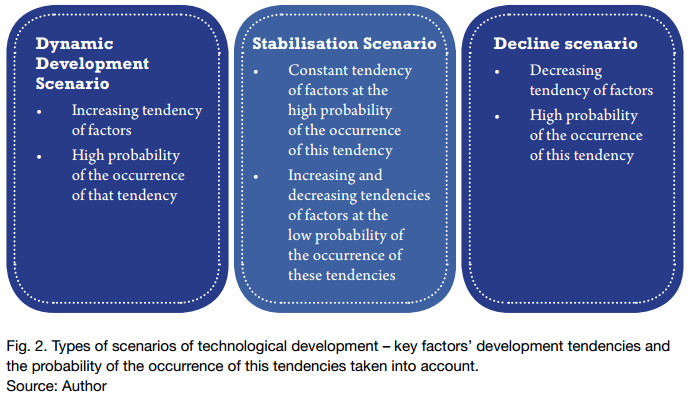
The development scenarios in the field of environmental technologies were then built on the basis of the results of expert analyses. The creation of three scenarios: dynamic development scenario, stabilisation scenario and decline scenario (Fig. 2) was proposed with consideration of development tendencies of individual factors and the probability of the occurrence of these tendencies.
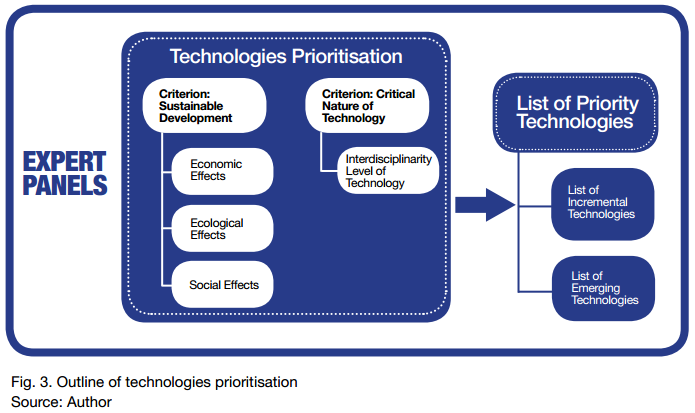
It was assumed that at the next stage of scenario building, the ranking of priority technologies and the results of technology implementation readiness assessment would be used. The list of priority technologies assessed according to the following criteria: sustainable development (embracing the sub-criteria of ecological, economic and social effects) and the critical nature of technologies including the level of the interdisciplinarity of the solutions were applied.7 (Fig. 3)
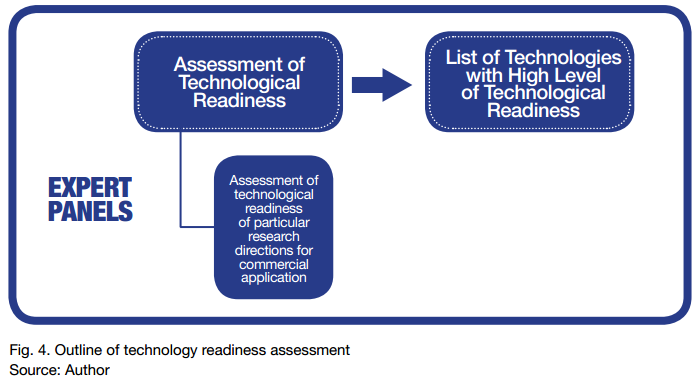
Technologies with ascribed level of priority were then compared with the results of the assessment of technological readiness of detailed research directions, within which incremental and emerging technologies had been identified (Fig. 4). Technological readiness level concerned the possibility of undertaking or continuing the activity in the selected research direction, which should result in a design of advanced incremental and emerging technologies. It was assumed that technologies at the commercialisation and diffusion level, crucial for the development of competitiveness, and the incremental technological progress, together with the generic technologies of basic importance for the creation of technological competitiveness guaranteeing technological progress were the technologies of high technological readiness.
In order to simultaneously consider the level of priority and technological readiness of priority technologies, a matrix, was designed which hypothetically allowed to identify the following lists of technologies:
• High-priority technologies with a high level of technological readiness,
• High-priority technologies with a low level of technological readiness,
• Low-priority technologies with a high level of technological readiness,
• Low-priority technologies with a low level of technological readiness.
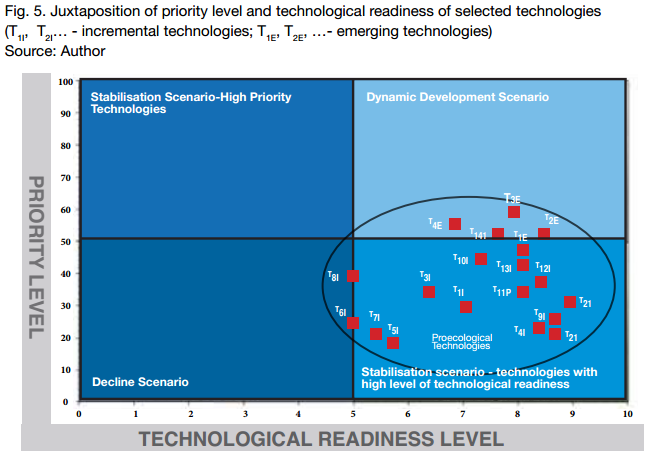
The matrix for the area of environmental technologies is presented in (Fig. 5). The individual quarters of the matrix hold the technologies (research directions) complying with the priority and technological readiness levels.
Within the framework of this stage of the research in the domain of environmental technologies, the following results were confronted:
• list of technologies of high priority and high level of technological readiness and technologies and research directions identified in the dynamic development scenario built with the consideration of development tendencies of key factors together with the probability of the occurrence of these tendencies;
• list of technologies of low priority with high level of technological readiness and technologies and research directions identified in the stabilisation scenario built with the consideration of development tendencies of key factors together with the probability of the occurrence of these tendencies
The results obtained, formed the basis for the creation of technological progress scenarios identifying priority research directions and technologies, for which there are great development possibilities in Poland and whose development is determined by the changes of tendencies of key factors influencing the dynamics of the R&D work in the area of environmental technologies. At the time of their building, it was assumed that scenarios should take into consideration the research directions and within their framework the technologies whose development and implementation would result in a higher technological level and the growth in competitiveness of businesses in which innovative environmental solutions are applied. Additionally, the identification and forecasting of needs concerning knowledge, skills and competences necessary for the creation and application of new technologies, as well as the development of recommendations for future occupations, qualifications and modular system solutions are also of great importance, as they result in an effective organisation and realisation of educational processes and the retraining of personnel to meet the requirements of advanced industrial technologies.
On the basis of the confrontation of technologies assessed according to the priority and technological readiness criteria with technologies and research directions indicated by the scenarios considering the development tendencies of key factors and the probability of the occurrence of these tendencies in the area of environmental technologies, the dynamic development and the stabilisation scenario were built .
Dynamic Development Scenario For Environmental Technologies
The research carried out in the domain of environmental technologies is mainly determined by the research directions in other scientific areas, including: material technologies, nanotechnologies, mechatronic technologies, test and research apparatus and technical and environmental safety technologies, as well as the necessity to comply with legal regulations concerning environmental protection.
Environmental technologies are characterised by a high level of interdisciplinarity, technical advancement and flexibility as well as high complexity and multiscale. Emerging technologies that are currently being developed in this scientific domain are innovations creating the possibility to rank high on competitiveness. The examples of such technologies include: technologies of biomass liquidation and gasification, production of energy from waste, recycling of resources and materials and technologies of co-combustion of scrap biomass with conventional fuels. The development of highly effective technologies of gaining energy from reusable sources is characterised by its growing importance among emerging environmental technologies.
As far as environmental technologies are concerned, the ratio of costs to immediate financial benefits is higher when taking short term perspective into consideration. This apparent dominance of costs over the effects mainly stems from the public’s habit to concentrate on short term objectives, lack of consideration towards greater time scale of sustainable development and the difficulty to estimate ecological advantages the implementation of these technologies would bring. In many cases, this attitude leads to growing ignorance and sometimes even the lack of society’s approval towards spending public funds on the development and implementation of these technologies.
Usually that happens in the case of technologies whose development and implementation result from the necessity to adjust national economy to international requirements and legislation concerning protection of the environment and the climate. The development of advanced environmental technologies has one extremely crucial effect, though – it leads to the rationalisation of the use of raw materials and resources, which is the requisite of a permanent sustainable development of the economy.
Stabilisation Scenario For Environmental Technologies
The development of environmental technologies is characterised by low dynamics and the continuation of research activity in existing directions leading to the improvement of already known solutions. The technologies analysed are of average priority for sustainable development and have either high or average level of technological readiness. Many solutions are designed and implemented to meet the norms and standards concerning environmental protection and their character is rather temporary and incidental. Long term ecological actions for the protection of the environment for future generations are of secondary importance and the emphasis is put on the development of technologies that enable the removal and repair of already existing environmental damage.
The most intensive is the development of incremental solutions directed at the improvement of existing solutions exercised through the gradual implementation of novel ideas based on new knowledge. Incremental research concerns the advancement of current technologies or their implementation in new application areas. Technologies developed include technologies for the rationalisation of the use of materials and resources, with greatest attention paid to waste recycling and utilisation technologies, technologies of textile and thermoplastic polymer composites recycling, technical systems for the support of environmental maintenance of operating fluids, application of membrane systems in recycling and utilisation technologies for aqueous operating fluids and sewage, technologies of production and regeneration of elements of machines and devices with the application of polymer nanocomposites. Besides, technologies of co-combustion of flammable waste with conventional fuels and methods of stabilisation and improvement of operational properties of biofuels. This is accompanied by the development of logistics systems for waste and energy management including: systems for on-line measurement of volatile and solid products of combustion and devices for their realisation. Parallel is the development of production technologies for maintenance materials with increased ecological qualities, among which there are specialised ecological operating fluids on the basis of non-toxic, biodegradable natural and synthetic components.
Qualifications and Competences Development Scenarios
Environmental technologies, rationalisation of the use of raw materials and resources and reusable energy sources are an important element of knowledge transfer to education, which facilitates country’s sustainable development. Constant progress characterises the process of gaining knowledge, skills and competences in the domain of environmental technologies. Technical faculties should offer complex, interdisciplinary vocational training mingled with knowledge of specialised innovative environmental technologies, as well as knowledge of the environment itself and its protection complying with the principles of sustainable development.
Specialised and interdisciplinary knowledge together with the latest knowledge of chemistry, physics, material engineering, ecology, biotechnology and nanotechnology for instance, are needed for the development of environmental technologies. The existing educational system focuses on formal education, which results in the lack of legal and institutional regulations and procedures that would acknowledge the process of informal and non-formal education of the employee within or outside their work place. Promotion of continuing environmental education needs to be accompanied by its development consisting of the creation and reorganisation of the continuing education centres offering educational programmes suitable for the needs and capabilities of various specialists. Moreover, it is important to extend the educational field of activity of technology transfer offices (i.e. technology parks, technology transfer offices, entrepreneurship incubators) and incorporate into their curricula professional training courses for the needs of development and implementation of innovative technologies.
Implementation of the scenarios in the form of strategic programmes
The priority research directions and incremental and emerging technologies identified in the scenarios form the scope for future thematic areas that should be considered for realisation within the framework of research projects, especially in the form of national strategic programmes. It is assumed, that there will be two kinds of research projects conducted in the future: highly specialist programmes limited to the selected thematic area, characterised by a very high level of minuteness of details and a close participation of scientific organisations specialising in that particular field, and interdisciplinary programmes covering vast thematic areas penetrating one another. The success of research and scientific institutions will depend on their participation in both of those types of projects as well as on the development and implementation of effective procedures of research results transfer and industrial deployment in the form of advanced process and product technologies.
Selected priority research directions and technologies have been included in the “Innovative Systems for the Technical Support of Sustainable Development of Economy” approved for realisation in the 2010-1014 period within European Structural Funds co-financing the Innovative Economy Operational Programme, within which the research realised focuses on incremental technologies development in a short (3-5 years) run. The technologies considered for realisation within this programme are the incremental technologies identified in the stabilisation scenario.
Proposed detailed research directions in the strategic programme “Innovative Systems for the Technical Support of the Development of Economy” correspond with the directions identified as priority directions in the sectoral foresight project. Some examples of the correlation of research directions is presented in (Tab. 1). The thematic area of environmental technologies ranks high on importance within the framework of the strategic research programme. The growing importance of this particular thematic area within the strategic programme is also confirmed by the increasing role of the aspects of energy saving and new, ecological sources of its acquisition and the question of environment protection and technical safety to maintain economic growth according to the principles of sustainable development, which has been emphasised in the new development strategy of the European Union – “Europe 2020.”
Furthermore, as a result of conducted research, a thematic scope for the strategic programme “Advanced Technologies of the Future for Sustainable Development” encompassing the subjects directed at the development of research in priority directions in the long (10-15 years) run was identified. Within the framework of the programme, emerging technologies, indicated in the scenario of the dynamic development within the sectoral foresight project, will be mainly considered.
It has been assumed that the proposed structure of the strategic programme will only encompass those thematic areas which are of key importance from the perspective of the current strategic documents of the European Union, including “Europe 2020” Strategy, complying with the priorities concerning the support for power engineering industry, technical and environmental protection and safety. Among the thematic areas proposed in the strategic programme, there are groups particularly connected with ecology: innovative energy systems and the rationalisation of the usage of resources; environmental protection and technical safety technologies.
Conclusions
Due to great significance of the effective development and implementation of environmental technologies, as well as the necessity to create technological solutions in this area, there is a need for the identification of priority research areas and their correlation in accordance to the research potential of the entire country, region and the strategic research institute. For that, methodology of identifying and selecting priority research direction has been designed. Its application is an effective tool enabling the generation of future research directions with the consideration of their development and implementation capability, for instance through strategic research programmes realised within European and national funds. An example of the strategic programme whose subject matter has been generated with the use of the methodology developed, is the “Innovative Systems of Technical Support for Sustainable Development of Economy” project coordinated by the Institute for Sustainable Technologies-National Research Institute in Radom, Poland, co-financed by the European Structural Funds.
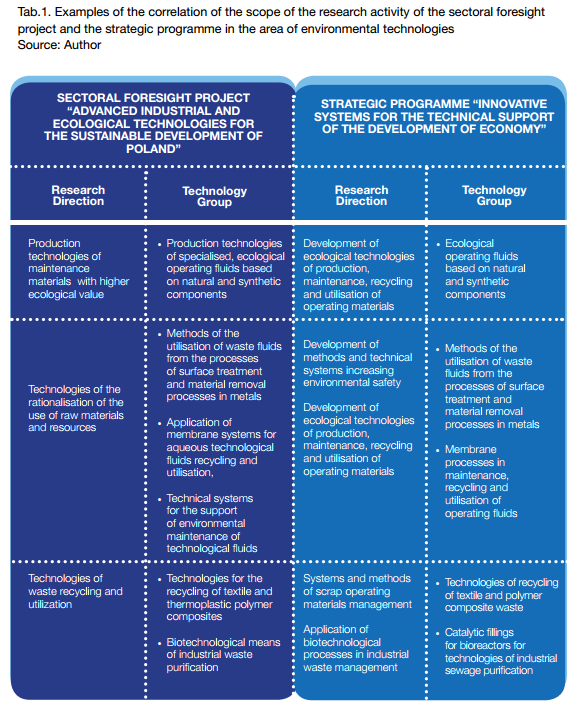
On the basis of the state-of-the-art and expert analyses, selected research directions and technologies should be continuously updated to incorporate latest trends in technological development, and then introduced for realisation in scientific organisations. The computer system, which is planned to assist the forecasting of research directions crucial for the development of competitiveness and innovativeness of Polish enterprises and technological institutes, will support this area of research activity. The adaptation of technological foresight methods for the application in research institutions in order to identify the probable development tendencies of research directions and technologies was the underlying assumption in the creation of the computer system. Moreover, it has been assumed that the computer system will enable the integration of qualitative, semi-quantitative and quantitative methods with expert knowledge.
The computer system will be equipped with a medium- and long-term forecasting module that will allow for the automation of the process of generating multidimensional spheres of key change factors, ranking technologies according to their innovativeness and competitiveness, and identifying the sets of the most probable hypotheses.The expertise of both internal and external experts will be fed into the computer system.
The designed system will comprise a useful tool for the support of generation of future research directions and technologies and the creation of scenarios of their development. It will assist in the creation and implementation of strategies for a research organisation in the area of generating the directions of the research both in the short and the long term. It will also assist in the planned and realised development of its infrastructure according to the priority research areas selected for the institution.


